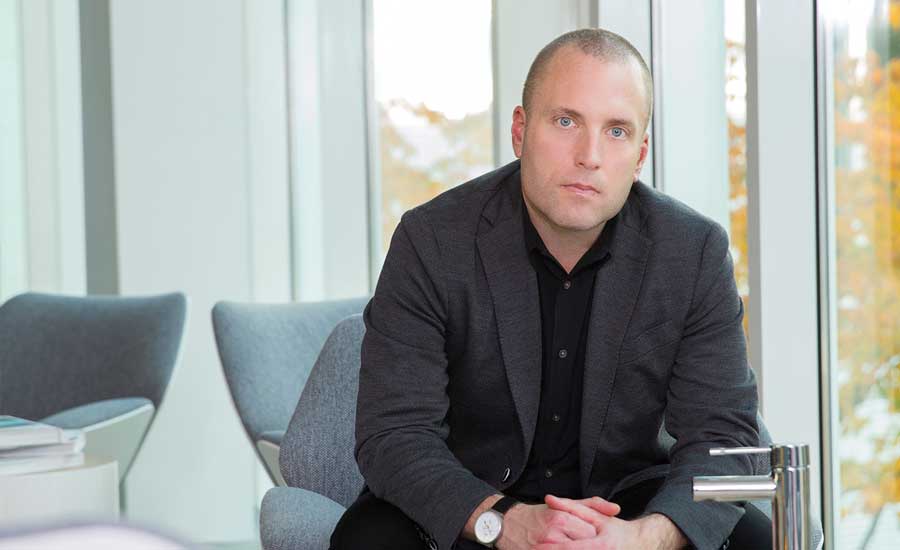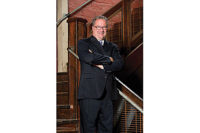Supply House Times interviewed GROHE Vice President of Design Michael Seum about bath and kitchen design trends March 14 during the ISH trade show in Frankfurt, Germany. A native of Chicago, Seum joined GROHE in 2015. He previously held design positions with Kohler Co. and Whirlpool Europe.
Supply House Times: Do you design products differently for the U.S. than you do for the European market?
MS: Yes, we have quite a few lines that are dedicated to the U.S., but when we design lines, we try for a global product. For example, when we design a line sold in Ferguson showrooms, it’s for them, specifically. We do that quite a bit.
With me coming from the States, I have a deep understanding of the market there. At the same time, the brand has to be firmly rooted in the heritage of GROHE with a German-based approach to design. It’s a European design brand and we should be seen as European design brand in the U.S., so we have to understand the needs of our customers.
Supply House Times: In the GROHE booth here at ISH, I was struck by the phrase “sensual minimalism” to describe a line of products. Can you define that?
MS: You were looking at Lineare, which is a redesign of an existing line. The original line is beautiful and we wanted to treat it with respect. Minimalism in general can often be quite hard, harsh and a little cold. “Sensual” minimalism softens it up a bit, warms it up. Think about it in this sense: If you have a commercial kitchen, and you try to bring the commercial kitchen into the home, it doesn’t often translate.
So, we’ve taken minimalism and we’ve softened it with a bit more organic geometry. It still reads as a very modern clean line, with softer bends and more fluid touch points. It’s a really nice philosophy for us. The response to it here at ISH has been fantastic.
Supply House Times: Would this be an example of a product line you would design both for the European and U.S. markets?
MS: It’s such simple geometry that it will do really well in the U.S. when we introduce it later this year. I think it will translate globally, too. Lineare is basically a cylindrical rectangular geometry. It works well with round and rectangular basins. It’s a flexible line that’s very slim. I think we hit a sweet spot with this particular line.
Supply House Times: As a designer, what bath and kitchen products excite you the most?
MS: I spend a great deal of my time on our SmartControl. We have an exposed version and we just launched a concealed version. It’s an absolutely fantastic experience. It’s an analogue product that almost feels digital with the control and the projection. It is the big innovation for GROHE.
The biggest problem with the shower is no matter where I am in the world, I always stand there and think: “What if I pull this, where is the water going to come from? Is it coming from the hand shower or the showerhead?” It’s a problem we’ve solved beautifully. You push a button; it’s intuitive.
Then you have the volume control so you can adjust the spray intensity. This is unrivaled in the industry. It’s really interesting from an experience perspective because as you think about your behaviors in the shower, you change modes. Sometimes you’re soaping yourself down, sometimes you need to rinse. You can adjust power, you can adjust volume. It’s just such a dynamic experience. It’s easy and really precise.
Supply House Times: Are wall-hung toilets a trend that will continue to gain strength in the U.S. market?
MS: I hope the U.S. market embraces this design because it makes sense not only for aesthetics but from a cleanability perspective. I was asked earlier today about what would I do in my bathroom and I said immediately, “I would lift everything off the floor.” It’s a wet environment where you want to be able to easily access the floor.
I think American consumers will love this design once they have it. There are beautiful floor-standing products, but once you have a wall-hung toilet you realize it saves space, it saves time, it’s a clean and it’s a much better looking product.
Wall-hung toilets are a big growth area for us. You will see from GROHE a true investment in ceramics due to our parent company’s expertise there.
Supply House Times: Does GROHE still see water conservation/green products as a major trend in the bath and kitchen space?
MS: Water scarcity is something we all should be concerned about. It’s not just from a design development perspective. It’s also: Where do our suppliers’ materials come from, are they getting high-quality materials, and are they being good to the environment? As a brand, GROHE was nominated for a German government corporate social responsibility award, and we won. We have a true commitment to sustainability.
As a designer, I believe the most sustainable products are the ones that last the longest. A quality product is something you invest in. It’s high-quality material, very well-engineered; it’s going to last, and you’re going to experience the quality from day one. I think that’s the difference between buying a GROHE product or a store-brand product, so I think sustainability can be expressed in other ways.
Another example would be our Blue Home system. In Germany, bottled water consumption is very high, but it’s also very high in the U.S. If you took a bottle of water today and set it on the table, you have to realize it takes seven times the amount of water that’s in the bottle to produce that bottle. We want to change that.
Our Blue system allows you to use 1 liter of water to consume 1 liter of water produced, not 7 liters. That’s really the power of the product. It’s completely safe. It’s un-bottled water you can drink safely from the tap – carbonated, filtered or chilled. It’s a really amazing product that is available in the U.S.
PM: Do you see any other trends that are uniquely American?
MS: From a trends perspective, we’re seeing U.S. consumers were very traditional in their design choices. All the data now show contemporary design taking a much stronger role. As people are upgrading their bathrooms, they’re going from traditional to contemporary. This is a great opportunity for GROHE because we have a true heritage in the contemporary design space. I hope the American market can embrace some of the European design principles around the bathroom as well. I think it’s happening.
One thing U.S. consumers do really well is they’ve embraced color-finished materials in their bathrooms. And that will continue to happen. It used to be oil-rubbed bronze, but now the colors are getting more sophisticated. Blacks are becoming more popular. I see a lot of high-contrast colors coming into the U.S. For example, white subway tiles are very common but now consumers are putting in matte black shower systems and contrasting that space. That’s a really cool trend. It leads to a nice design statement.
Supply House Times: What will be the next big technology advancement in baths and kitchens?
MS: The next big thing for us is to inject intelligence between water and enjoyment. So, water, intelligence and enjoyment with GROHE. Intelligent doesn’t necessarily mean it’s a digital product. It just means it can be a smarter solution. We continue to see this opportunity, but we also are launching a product that’s derived from safety and water security.
There’s a big opportunity to prevent water damage within homes. GROHE Sense and Sense Guard comprise an ecosystem or a family of products. The Sense product detects humidity and room temperature; if there’s a flood it will activate an app that will alert you. If you have both the products working together, the Guard goes into your plumbing, and it will actually shut off the water supply. It works unattended.
The U.S. has embraced this market very well with the Nest thermostat from Google. This is our equivalent for water saving. We’re launching Sense in May. And then Sense Guard will be two months after that.
Supply House Times: What products will bathrooms in the future have that they don’t have today?
MS: The change in bathrooms has been dramatic, even in the last 20 years. So, it’s for sure the bathroom and kitchen are going to evolve rapidly. One area I’m really excited about is the role of health and wellness in the bathroom.
If you look at what consumers are doing today with wearables and all sorts of technology, it’s a natural evolution that, at some point, you will be able to collect some really important data from toilets to know, for example, whether you’re hydrated properly. That’s really exciting. We’ve got to get past the personal data issue, but I think we can get to the point where we can help somebody live a longer life.
Supply House Times: Do you see growth for GROHE on the nonresidential side of the U.S. plumbing market?
MS: We do a lot within residential and project-based business. I spend a fair amount of my time talking to architects. I’ve just met with a very important customer who designs larger hotels. I try to understand their needs and what we can do to better serve them. So we’re not just looking at residential. There are big opportunities for us with water safety and water management resources in large buildings and complex ecosystems.
Supply House Times: Is the perception of GROHE within the German plumbing industry different than it is within the U.S.?
MS: We just did a global brand study and I’m very happy to see we have such a powerful brand. What we have in the U.S. is the opportunity to drive the brand even further. Our ambition is to grow greatly in the U.S. and it’s a particular area that I’m very focused on as well.
GROHE is a brand people know at various price points. We go from the spa range all the way down to the do-it-yourself range. In the U.S., the brand has probably more of a premium perception. Our market share is strongest obviously in Germany but that’s why the U.S. remains a big opportunity for us.
This article was originally titled “Bathrooms of the future” in the July 2017 print edition of Supply House Times.







